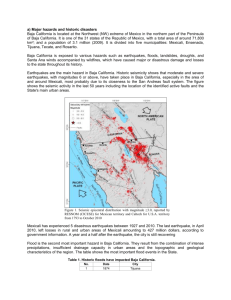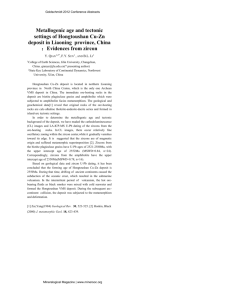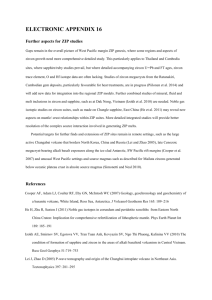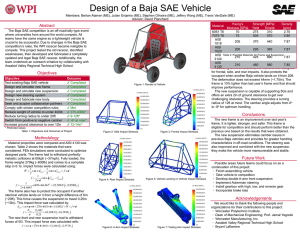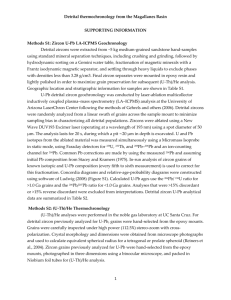TheCase
advertisement
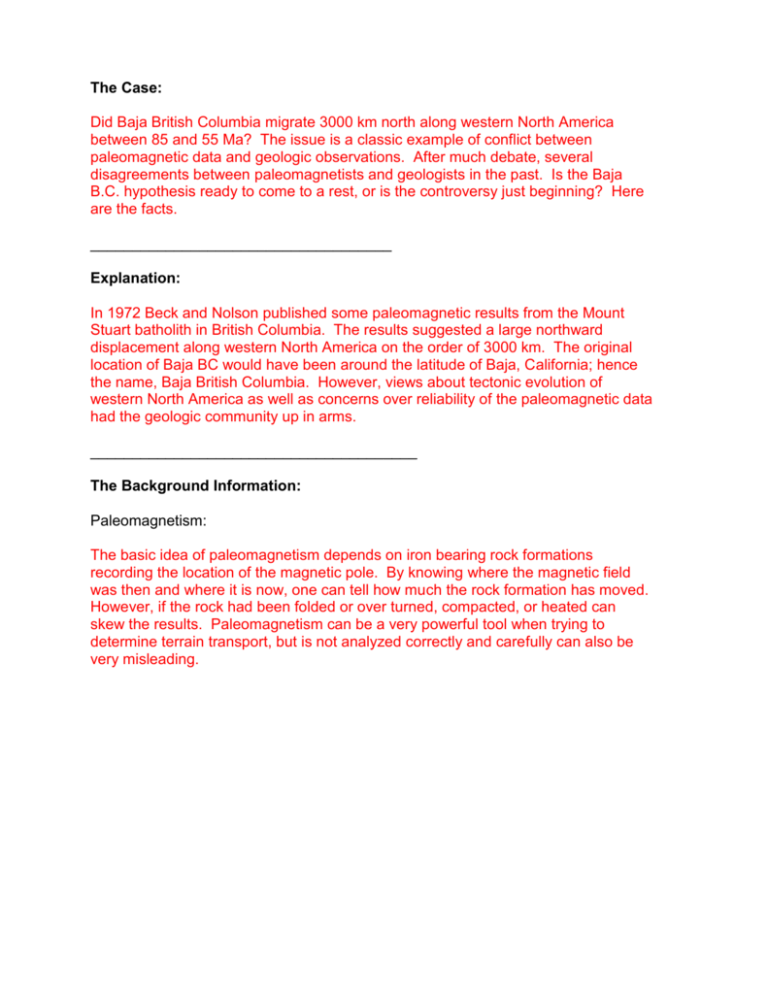
The Case: Did Baja British Columbia migrate 3000 km north along western North America between 85 and 55 Ma? The issue is a classic example of conflict between paleomagnetic data and geologic observations. After much debate, several disagreements between paleomagnetists and geologists in the past. Is the Baja B.C. hypothesis ready to come to a rest, or is the controversy just beginning? Here are the facts. ____________________________________ Explanation: In 1972 Beck and Nolson published some paleomagnetic results from the Mount Stuart batholith in British Columbia. The results suggested a large northward displacement along western North America on the order of 3000 km. The original location of Baja BC would have been around the latitude of Baja, California; hence the name, Baja British Columbia. However, views about tectonic evolution of western North America as well as concerns over reliability of the paleomagnetic data had the geologic community up in arms. _______________________________________ The Background Information: Paleomagnetism: The basic idea of paleomagnetism depends on iron bearing rock formations recording the location of the magnetic pole. By knowing where the magnetic field was then and where it is now, one can tell how much the rock formation has moved. However, if the rock had been folded or over turned, compacted, or heated can skew the results. Paleomagnetism can be a very powerful tool when trying to determine terrain transport, but is not analyzed correctly and carefully can also be very misleading. Figure 1. The Paleomagnetic Pole = PP, the arrows at the surface represent the dipolar magnetic field inclination with respect to PP. If a block of crust is magnetized and then displaced northward at angular distance p, the observed paleomagnetic inclination will be smaller. The latitudinal shift towards the paleomagnetic pole causes the inclination to flatten by angle F. Taken from ______ for more detailed information on paleomagnetic calculations, please consult: http://www.geo.arizona.edu/Paleomag/book/ Fission-Track Detrital Zircons: Zircon grains are a detrital component of clastic sediments. The grains are accessory minerals in igneous or metamorphic rocks. Because they are very stable during erosion and transport, they are also commonly found in sediments. Trace amounts of uranium cause fission tracks to form within the crystal. The density of fission tracks is proportional to the amount of uranium in the zircon. (Geotrck 1998) Products of radiogenic decay are measured by counting the etched fission tracks under a high powered microscope (>1000x). Once a detrital zircon age distribution is measured it can be linked to an igneous or metamorphic source, providing clues on basin evolution, tectonic history, and paleogeography. Zircon age data are plotted on histograms with superimposed probability density distributions. This method does not work if the zircon is heated above its annealing temperature (240 degree C), then fission track age is reset to zero (Barnet and Spiegel 2002). Figure 2 is an example of an age histogram and probability distribution. The bottom figure is an example of cumulative probability plots for all samples in the stratagraphic section. Figure 2. ____________________________________________________ The Defense: Paleomag The paleomagnetic data suggest that the Insular super-terrain and related coastal mountains’ origin was 3000 km to the south during the middle to late Cretaceous. About 85 to 55 MA the super-terrain was transported northward along the North American coast to its current location on the British Columbia coast. This is the main idea behind the Baja BC hypothesis (Cowan et al. 1997). Figure 3. (cowen) Because this is a case of latitude transport, the paleolatitudes must be defined, there are two ways of doing this. The first is by paleomagnetism. The second way is to identify the ancient climate (tropical or polar) recorded in the rocks. Faunal data from Baja BC do not provide paleolatitude information beyond Jurassic ammonites having Tethyan and South American affinities, which is not useful in the Baja BC debate (Keppie and Dostal 2001). To disprove the Baja BC hypothesis the paleomagnetic data must not include poleward transport. Tilting of Cretaceous plutonic rocks, compaction of sedimentary rocks, or synfolding remagnetization of volcanic rocks would all cause errors in the paloemagnetic interpretations. (Housen and Beck 1999). However, since the original data was published in 1972, several more paleomagnetic studies by different authors have been conducted, all showing similar results. No evidence of the above causes of error have been identified. Ague and Brandon (1996) investigated the possibility of tilting of Mount Stuart and concluded it had only been tilted 8 degrees and posed no significant change in paleomagnetic inclination. In order for compaction to cause a problem, sediments would have to compact enough to shallow the inclination by 30 degrees, Kodama and Ward (2001) found shallowing was no more than 16 degrees. No significant rotation evidence has been found either (Housen and Beck 1999). Fold tests established a 100 percent pre-folding age for the remnants of the rocks studied (Housen et al. 2003). Zircons Mahoney et al (1999) concluded that there was no plausible explanation for Archean zircons in the Baja BC province if the hypothesis was true. However, Housen and Beck (1999) argued that the zircon data supports the Baja BC hypothesis. Figure 1 shows the histogram data of U-Pb ages of detrital zircons from Mahoney et al. (1999) and Mustard et al. (1995), and basement ages of North America modified from Hoffman (1989). The circles denote the positions of Baja BC relative to North America and the arrows denote the location of Baja BC during deposition of units where detrital zircon ages are available. Housen and Beck (1999) claim the decline in Grenville zircons in the upper units reflects the movement of Baja BC north, away from Grenville crust in southwestern North America. Figure 4. (Housen and Beck) Plume Magnetism Keppie and Dostal (2001) propose that volcanic rocks in northern Stikinia can be correlated with the Yellowstone hotspot track, confirming 2000 km of northward displacement. The absence of these volcanic rocks in Baja BC indicates Baja BC was considerably south of Stikina during the Cretaceous. Prosecution: Zircons The Methow/Methow-Tyaugton basin, sedimentary basins within the Canadian Cordillera, can be linked to source regions to the east in the southern Canadian Cordillera. These results suggest the 3000-kilometer northward migration of Baja BC unlikely because there are no known southern source regions for the detrital zircon grains. The data are the result of high-resolution sampling and show significant heterogeneity (DeGraaff-Surpless et al. 2003). The figure below is a comparison of composite detrital zircon and signatures from Methow/MethowTyaighton strata with the potential Cordilleran source regions (map). (Check this last sentence to make sure it says what you want. Remember to not get too wordy) Closing Statements: In 1997 Cowen suggested the only way to resolve the Baja BC controversy was to perform "crucial tests." Not only more testing of paleolatitudes, but more importantly tests independent of paleomagnetic data. Cowen (1997) also considered more paleo tests incredibly vital in working out a solution to the Baja BC controversy that the scientific community will accept. Fission track analysis of detrital zircons, though open to interpretation, is an excellent start. However, in order to disprove the Baja BC hypothesis completely those with objective opinions must come up with some definitive, concrete theory. Figure 5.

